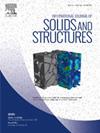Thermomechanical performance of double-phase periodic and graded architected materials: Numerical and explainability analysis
IF 3.4
3区 工程技术
Q1 MECHANICS
International Journal of Solids and Structures
Pub Date : 2024-11-30
DOI:10.1016/j.ijsolstr.2024.113159
引用次数: 0
Abstract
The work investigates the effective thermomechanical performance of double-phase architected materials as a function of their inner design. The effective thermal conductivity, Young’s and shear moduli of double-phase composites, engineered with a wide range of Gielis’-formula-based topological architectures are analyzed, deriving analytical expressions for their effective performance. Thereupon, the effect of the addition of a second thermally isolating or conductive and mechanically soft or stiff phase is quantified for different phase combinations, including metal–metal, metal–ceramic or metal–epoxy designs, material pairs encountered in engineering practice. Moreover, the impact of material grading is assessed, establishing and quantifying differences among the effective mechanical and thermal attributes. It is shown that the Young’s modulus is mainly controlled by the shape of the second phase, while the effective thermal conductivity arises as a combination of the underlying pattern and phase properties. High-fidelity neural network (NN) models are developed and used as a basis for interpretability, SHapley Additive exPlanations (SHAP) analysis. Highly nonlinear dependencies on the inner design features are reported, with feature interactions well-beyond the bounds of single-phase material designs. The role of shape effects is quantified as more prominent for comparatively low conductivity and soft second phase designs. In such a space, the Young’s and shear modulus are 33% and 100% more sensitive to the inner structural pattern than the effective thermal conductivity . The relative significance of topology is substantially mitigated for composites with comparable phase conductivities and stiffness ratios, with importance values that are nearly seven times lower than the ones computed for the second phase volumetric content.

求助全文
约1分钟内获得全文
求助全文
来源期刊
CiteScore
6.70
自引率
8.30%
发文量
405
审稿时长
70 days
期刊介绍:
The International Journal of Solids and Structures has as its objective the publication and dissemination of original research in Mechanics of Solids and Structures as a field of Applied Science and Engineering. It fosters thus the exchange of ideas among workers in different parts of the world and also among workers who emphasize different aspects of the foundations and applications of the field.
Standing as it does at the cross-roads of Materials Science, Life Sciences, Mathematics, Physics and Engineering Design, the Mechanics of Solids and Structures is experiencing considerable growth as a result of recent technological advances. The Journal, by providing an international medium of communication, is encouraging this growth and is encompassing all aspects of the field from the more classical problems of structural analysis to mechanics of solids continually interacting with other media and including fracture, flow, wave propagation, heat transfer, thermal effects in solids, optimum design methods, model analysis, structural topology and numerical techniques. Interest extends to both inorganic and organic solids and structures.

 求助内容:
求助内容: 应助结果提醒方式:
应助结果提醒方式:


